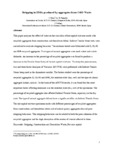Mostrar o rexistro simple do ítem
Stripping in hot mix asphalt produced by aggregates from construction and demolition waste
| dc.contributor.author | Pérez Pérez, Ignacio | |
| dc.contributor.author | Pasandín, A.R. | |
| dc.contributor.author | Gallego Medina, Juan | |
| dc.date.accessioned | 2016-12-23T19:59:10Z | |
| dc.date.available | 2016-12-23T19:59:10Z | |
| dc.date.issued | 2012 | |
| dc.identifier.citation | PÉREZ PÉREZ, I.; PASANDÍN, A. R.; GALLEGO MEDINA, J. 2012. Stripping in hot mix asphalt produced by aggregates from construction and demolition waste. Waste Management & Research, 30 (1), pp. 3-11. ISSN 1096-3669. Disponible en: https://dx.doi.org/10.1177/0734242X10375747. | es_ES |
| dc.identifier.uri | http://hdl.handle.net/2183/17844 | |
| dc.description.abstract | [Abstract:] This paper analyses the effect of water on the durability of hot asphalt mixtures made with recycled aggregates from construction and demolition debris. Indirect tensile stress tests were carried out to evaluate stripping behaviour. The mixtures tested were fabricated with 0, 20, 40 and 60% recycled aggregates. Two types of natural aggregates were used: schist and calcite dolomite. An increase in the percentage of recycled aggregates was found to produce a decrease in the tensile stress ratio of the hot asphalt mixtures. To study this phenomenon, two and three factor analyses of variance (ANOVA) were performed with indirect tensile stress being used as the dependent variable. The factors studied were the percentage of recycled aggregates (0, 20, 40 and 60%), the moisture state (dry, wet) and the type of natural aggregate (schist, calcite). On the basis of the ANOVA results, it was found that the most important factor affecting resistance was the moisture state (dry, wet) of the specimens. The percentage of recycled aggregate also affected indirect tensile stress, especially in the dry state. The type of natural aggregate did not have a significant effect on indirect tensile stress. The hot asphalt mixture specimens made with different percentages of recycled aggregates from construction and demolition debris and of natural quarry aggregates showed poor stripping behaviour. This stripping behaviour can be related to both the poor adhesion of the recycled aggregates and the high absorption of the mortar of cement adhered to them. | es_ES |
| dc.language.iso | eng | es_ES |
| dc.publisher | SAGE Journals | es_ES |
| dc.relation.uri | https://dx.doi.org/10.1177/0734242X10375747 | es_ES |
| dc.subject | Stripping | es_ES |
| dc.subject | Construction and demolition waste | es_ES |
| dc.subject | Hot mix asphalt | es_ES |
| dc.title | Stripping in hot mix asphalt produced by aggregates from construction and demolition waste | es_ES |
| dc.type | info:eu-repo/semantics/article | es_ES |
| dc.rights.access | info:eu-repo/semantics/openAccess | es_ES |
| UDC.journalTitle | Waste Management & Research | es_ES |
| UDC.volume | 30 | es_ES |
| UDC.issue | 1 | es_ES |
| UDC.startPage | 3 | es_ES |
| UDC.endPage | 11 | es_ES |
| dc.identifier.doi | https://dx.doi.org/10.1177/0734242X10375747 |
Ficheiros no ítem
Este ítem aparece na(s) seguinte(s) colección(s)
-
CITEEC-CGM - Artigos [93]






